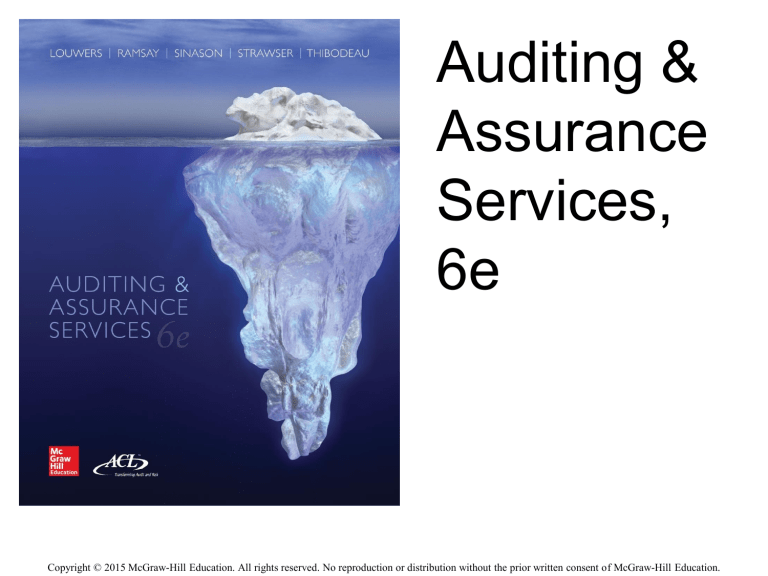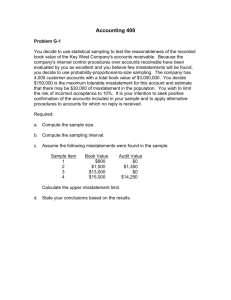
Auditing &
Assurance
Services,
6e
Copyright © 2015 McGraw-Hill Education. All rights reserved. No reproduction or distribution without the prior written consent of McGraw-Hill Education.
Module E
Overview of Sampling
There are three kinds of lies: lies, damned lies, and statistics.
Popularized by Mark Twain (pseudonym of Samuel L. Clemens),
famous American writer (1835 – 1910)
Mod E-2
Module E Objectives
1.
Understand the basic principles of sampling, including
the differences between statistical and nonstatistical
sampling and sampling and nonsampling risk.
2.
Understand the basic steps and procedures used in
implementing a sampling plan.
3.
Identify the two situations in which sampling is used in
an audit.
4.
Understand how the basic steps and procedures used in
a sampling plan apply to an audit.
Mod E-3
Major Topics
I.
Sampling Terminology
II.
Basic Steps in Sampling
III.
−
Planning
−
Performing
−
Evaluating
Audit Sampling
−
Attributes Sampling
−
Variables Sampling
−
Effect of Factors on Sample Size
Mod E-4
Sampling
• Sampling is the process of making a statement
about a population of interest by examining
only a subset (or sample) of that population
• When used?
– The need for exact information is less important
– The number of items comprising the population is
large
Mod E-5
Sampling Risk
• Likelihood that the decision based on the sample
differs from the decision that would have been
made if the entire population were examined
• Caused by selecting a nonrepresentative sample
• Can be controlled by
– Determining an appropriate sample size
– Ensuring that all items have an equal likelihood of
selection
– Evaluating sample results to control risk
Mod E-6
Nonsampling risk
• Likelihood that an incorrect conclusion is
drawn for reasons unrelated to the sample
• Most common cause is mistakes in
evaluating sample items
Mod E-7
Approaches to Sampling
• Statistical sampling applies laws of probability in
selecting sample items and evaluating sample
results
– Allows audit team to control exposure to sampling risk
• Nonstatistical sampling does not allow audit team
to control exposure to sampling risk
• Both statistical sampling and nonstatistical
sampling are appropriate under GAAS
Mod E-8
Major Topics
I.
Sampling Terminology
II.
Basic Steps in Sampling
III.
−
Planning
−
Performing
−
Evaluating
Audit Sampling
−
Attributes Sampling
−
Variables Sampling
−
Effect of Factors on Sample Size
Mod E-9
Steps in Sampling: Planning
1. Determine the objective of sampling
• Drawing conclusion about some population of interest (e.g.,
does brand of golf ball provide increased distance?)
2. Define the characteristic of interest
• Question of interest to person conducting sampling plan (e.g.,
golf ball distance)
3. Define the population
• Item(s) about which question is asked (e.g. all amateur golfers?)
• Need to ensure population is carefully and completely defined
Mod E-10
Major Topics
I.
Sampling Terminology
II.
Basic Steps in Sampling
III.
−
Planning
−
Performing
−
Evaluating
Audit Sampling
−
Attributes Sampling
−
Variables Sampling
−
Effect of Factors on Sample Size
Mod E-11
Steps in Sampling: Performing
4.
Determine sample size
•
5.
Under statistical sampling, sample size considers desired exposure to
sampling risk
Select sample items
• Ensure that all items are available for selection
6.
Measure sample items
• Perform procedure and make appropriate evaluation/measurement
• Determine sample estimate
• Nonsampling risk can occur if incorrect procedures are performed or
mistakes in evaluation or measurement are made
Mod E-12
Selecting Sample Items
• Methods
− Unrestricted random selection: Select items based on random
numbers matched to items in population
− Systematic random selection: Bypass a fixed number of items in
population, selecting every nth item
− Block selection: Select contiguous units
− Haphazard selection: Select items in a nonsystematic manner
• Can only use unrestricted random selection or systematic
random selection with statistical sampling
Mod E-13
Major Topics
I.
Sampling Terminology
II.
Basic Steps in Sampling
III.
−
Planning
−
Performing
−
Evaluating
Audit Sampling
−
Attributes Sampling
−
Variables Sampling
−
Effect of Factors on Sample Size
Mod E-14
Steps in Sampling: Evaluating
7. Evaluate sample results
• In statistical sampling, evaluating sample results
controls exposure to sampling risk
• Parameters
– Sample estimate
– Precision
– Reliability
Mod E-15
Precision and Reliability
• Precision (allowance for sampling risk): Distance from the
estimated population value in which the true (but
unknown) population value may lie with a given
probability.
• Reliability (confidence): Likelihood of achieving a given
level of precision
• Steps:
– Based on sampling procedure, form sample estimate
– Based on precision and reliability, form precision interval
Mod E-16
Example
• If
– Sample estimate = 6.7 yards
– Precision = 1.5 yards
– Reliability = 90%
• There is a 90% likelihood (reliability) that
the true population value is between 5.2
yards (6.7 – 1.5) and 8.2 yards (6.7 + 1.5)
Mod E-17
Precision Intervals
Sample Estimate = 6.7 yds
Interval = 5.2 yds to 8.2 yds
Precision = 1.5 yds
Sample Estimate = 6.7 yds
Interval = 3.7 yds to 9.7 yds
4 yds
Conclusion: Wilson’s golf
ball does not provide an
increase in distance
(sample would lead to
incorrect conclusion).
5 yds
6 yds
7 yds
8 yds
Precision = 3.0 yds
9 yds
Conclusion: Wilson’s golf
ball provides an increase in
distance (sample would
lead to correct conclusion).
Mod E-18
Documentation
• Involves all seven steps of sampling process
• Important judgments include:
– Factors affecting sample size and rationale for those
factors
– Method of selecting sample and summary of items
selected
– Method of measuring sample items and summary of
measurements
– Evaluation of sample results and overall conclusion
Mod E-19
Major Topics
I.
Sampling Terminology
II.
Basic Steps in Sampling
III.
−
Planning
−
Performing
−
Evaluating
Audit Sampling
−
Attributes Sampling
−
Variables Sampling
−
Effect of Factors on Sample Size
Mod E-20
Attributes Sampling
• Used to estimate the extent to which a
characteristic exists within a population
• Used in the auditor’s study of internal control
• Process
– Estimate the rate at which the client’s internal control
is failing to function effectively (upper limit rate of
deviation)
– Compare upper limit rate of deviation to an allowable
level (tolerable rate of deviation)
Mod E-21
Attributes Sampling: Making
the Decision
Upper Limit Rate
of Deviation
Upper Limit Rate
of Deviation
≤
>
Tolerable Rate of
Deviation
Rely on
controls as
planned
Tolerable Rate of
Deviation
Reduce
planned
reliance on
controls
Mod E-22
Risk of Assessing Control Risk
too Low (Risk of Overreliance)
• Occurs when
– Sample indicates controls are functioning effectively
– Controls are not functioning effectively
• Result?
– Auditors conclude that controls are functioning
effectively
– Effectiveness loss (do not reduce audit risk to sufficient
level)
Mod E-23
Risk of Assessing Control Risk
too High (Risk of Underreliance)
• Occurs when
– Sample indicates controls are not functioning effectively
– Controls are functioning effectively
• Result?
– Auditors conclude that controls are not functioning
effectively
– Auditors assess control risk at higher than necessary levels
– Efficiency loss (perform more effective substantive
procedures than necessary)
Mod E-24
Summary: Sampling Risks
Under Attributes Sampling
Decision Based on Population
Rely on internal
control as planned
(ARD ≤ TRD)
Decision
Based on
Sample
Reduce reliance on
internal control
(ARD > TRD)
Rely on internal
Correct decision
control as planned
(ULRD ≤ TRD)
Risk of overreliance
(risk of assessing
control risk too low)
Reduce reliance
Risk of underreliance
on internal control (risk of assessing
(ULRD > TRD)
control risk too high)
Correct decision
ARD = Actual rate of deviation
TRD = Tolerable rate of deviation
ULRD = Upper limit rate of deviation
Mod E-25
Major Topics
I.
Sampling Terminology
II.
Basic Steps in Sampling
III.
−
Planning
−
Performing
−
Evaluating
Audit Sampling
−
Attributes Sampling
−
Variables Sampling
−
Effect of Factors on Sample Size
Mod E-26
Variables Sampling
• Used to estimate the amount (or value) of some
characteristic of a population
• Used in the auditor’s substantive procedures
• Process
– Estimate the amount of misstatement (upper limit on
misstatement)
– Compare upper limit rate on misstatement to an
allowable level (tolerable misstatement)
Mod E-27
Variables Sampling: Making
the Decision
Upper Limit on
Misstatement
Upper Limit on
Misstatement
≤
>
Tolerable
Misstatement
Tolerable
Misstatement
Account
balance is
not
misstated
Account
balance is
misstated
Mod E-28
Risk of Incorrect Acceptance
• Occurs when
– Sample indicates account is not misstated
– Account is misstated
• Result?
– Auditors conclude that account is not
misstated
– Effectiveness loss (issue incorrect opinion on
misstated F/S)
Mod E-29
Risk of Incorrect Rejection
• Occurs when
– Sample indicates account is misstated
– Account is not misstated
• Result?
– Auditors conclude that account is misstated
– Auditors perform additional procedures
– Efficiency loss (perform more effective substantive
procedures than necessary)
Mod E-30
Summary: Sampling Risks
Under Variables Sampling
Decision Based on Population
Decision
Based on
Sample
Account is not
misstated
(AM ≤ TM)
Account is misstated
(AM > TM)
Account is not
misstated
(ULM ≤ TM)
Correct decision
Risk of incorrect
acceptance
Account is
misstated
(ULM > TM)
Risk of incorrect
rejection
Correct decision
AM
TM
ULM
= Actual misstatement
= Tolerable misstatement
= Upper limit on misstatement
Mod E-31
Summary of Sampling Risks
• Effectiveness losses
– Risk of overreliance (assessing control risk too
low)
– Risk of incorrect acceptance
• Efficiency losses
– Risk of underreliance (assessing control risk
too high)
– Risk of incorrect rejection
Mod E-32
Major Topics
I.
Sampling Terminology
II.
Basic Steps in Sampling
III.
−
Planning
−
Performing
−
Evaluating
Audit Sampling
−
Attributes Sampling
−
Variables Sampling
−
Effect of Factors on Sample Size
Mod E-33
Effect of Factors on Sample
Size
Factor
Effect
Explanation
Population size
Direct
As population is larger, need to sample more
items
Expected rate of deviation
(Expected misstatement)
Direct
As auditors expect higher level of deviations or
misstatements in population, need to sample
more items
Tolerable rate of deviation
(Tolerable misstatement)
Inverse
As auditors require lower level of deviations or
misstatements, need to sample more items
Sampling risk
Inverse
As auditors wish to reduce chance of incorrect
decisions, need to sample more items
Population variability
Direct
As population is more variable, need to sample
more items to obtain representative sample
Mod E-34




